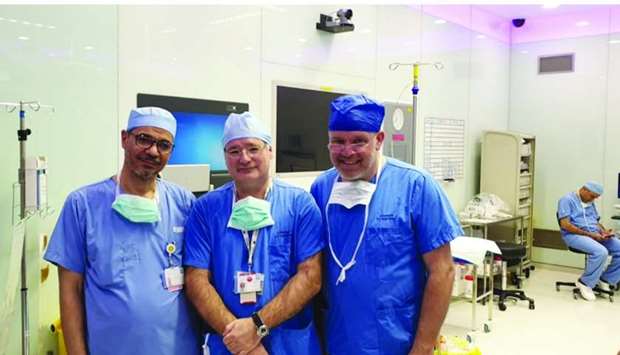* HMC first healthcare organisation in Middle East and 7th in world to introduce Evone ventilation technique
Teams from Hamad Medical Corporation’s (HMC) departments of Anaesthesiology and Perioperative Medicine and the Surgical Intensive Care Unit (SICU), in collaboration with specialists from seven international centres, have introduced a "revolutionary" mechanical ventilation technique for patients undergoing surgery at HMC.
In a statement on Saturday, HMC said it is the first healthcare organisation in the region, and seventh in the world, to introduce the new technique known as Evone. The technique provides surgeons and anaesthesiologists with a new and safer option for operating on patients with challenging airways.
Led by Dr Nabil al-Hamid Shallik, senior consultant and an expert in difficult airway management, and Dr Marcus Lance, senior consultant and a leading researcher and expert in thoracic anaesthesia, 20 patients at HMC have undergone surgery using the technique since it was introduced.
“Mechanical ventilators help patients’ breathe when they undergo surgery. Airway management and ventilation can be challenging in some patients, for example in patients who are in respiratory distress or who have a compromised airway. The Evone ventilator is a new device capable of lung ventilation through a narrow-bore cannula. The introduction of the Evone technique at HMC is significant because this system features an ultrathin tube with an outer diameter of only 4.4mm, compared to the more conventional tubes which are 10mm,” said Dr Shallik.
“The Evone technique provides surgeons and anaesthesiologists with extra working space in and around the airway and improved vision of the patient’s respiratory passageway. It also allows for the patients’ lungs to be better protected against damage. Preliminary studies indicate the Evone technique may lead to a considerable reduction in the number of lung complications related to conventional artificial ventilation,” added Dr Shallik.
Dr Shallik noted that Evone is the only ventilation appliance of its type. He said while it has been exclusively used at HMC on patients undergoing ENT, chest and upper airway surgeries, as well as in intensive care units, the technique has the potential to be used in various fields of surgery. Dr Lance echoes this sentiment, adding that he hopes to see the technique used on patients undergoing thoracic surgery.
Dr Mashael al-Khelaifi, HMC’s lead for paediatric anaesthesia, said she hopes to see the technique used in paediatric patients, noting that internationally published case reports indicate there are substantial benefits to using the Evone technique on patients under the age of 18 years.
Professor Marco Marcus, HMC’s chairman of anaesthesiology, Intensive Care Unit and Perioperative Medicine, said the implementation of the new technique at HMC "demonstrates Hamad’s commitment to combining clinical innovation with ongoing research".
“Teaching innovative techniques to residents, fellows, and HMC faculty, as well as healthcare professionals from within the Middle East region is the role of an academic healthcare system like HMC. By using techniques like this, our training programs will be the best in the Middle East,” said professor Marcus.
In a statement on Saturday, HMC said it is the first healthcare organisation in the region, and seventh in the world, to introduce the new technique known as Evone. The technique provides surgeons and anaesthesiologists with a new and safer option for operating on patients with challenging airways.
Led by Dr Nabil al-Hamid Shallik, senior consultant and an expert in difficult airway management, and Dr Marcus Lance, senior consultant and a leading researcher and expert in thoracic anaesthesia, 20 patients at HMC have undergone surgery using the technique since it was introduced.
“Mechanical ventilators help patients’ breathe when they undergo surgery. Airway management and ventilation can be challenging in some patients, for example in patients who are in respiratory distress or who have a compromised airway. The Evone ventilator is a new device capable of lung ventilation through a narrow-bore cannula. The introduction of the Evone technique at HMC is significant because this system features an ultrathin tube with an outer diameter of only 4.4mm, compared to the more conventional tubes which are 10mm,” said Dr Shallik.
“The Evone technique provides surgeons and anaesthesiologists with extra working space in and around the airway and improved vision of the patient’s respiratory passageway. It also allows for the patients’ lungs to be better protected against damage. Preliminary studies indicate the Evone technique may lead to a considerable reduction in the number of lung complications related to conventional artificial ventilation,” added Dr Shallik.
Dr Shallik noted that Evone is the only ventilation appliance of its type. He said while it has been exclusively used at HMC on patients undergoing ENT, chest and upper airway surgeries, as well as in intensive care units, the technique has the potential to be used in various fields of surgery. Dr Lance echoes this sentiment, adding that he hopes to see the technique used on patients undergoing thoracic surgery.
Dr Mashael al-Khelaifi, HMC’s lead for paediatric anaesthesia, said she hopes to see the technique used in paediatric patients, noting that internationally published case reports indicate there are substantial benefits to using the Evone technique on patients under the age of 18 years.
Professor Marco Marcus, HMC’s chairman of anaesthesiology, Intensive Care Unit and Perioperative Medicine, said the implementation of the new technique at HMC "demonstrates Hamad’s commitment to combining clinical innovation with ongoing research".
“Teaching innovative techniques to residents, fellows, and HMC faculty, as well as healthcare professionals from within the Middle East region is the role of an academic healthcare system like HMC. By using techniques like this, our training programs will be the best in the Middle East,” said professor Marcus.



